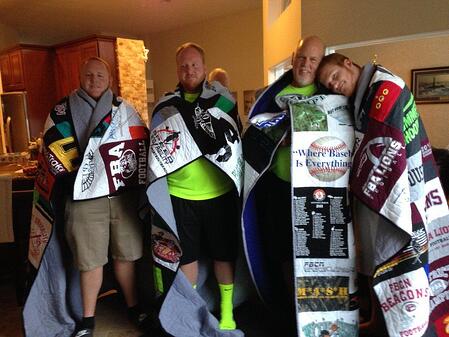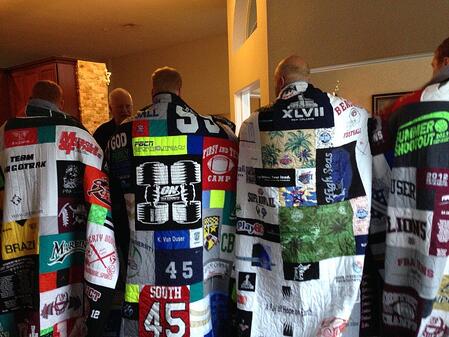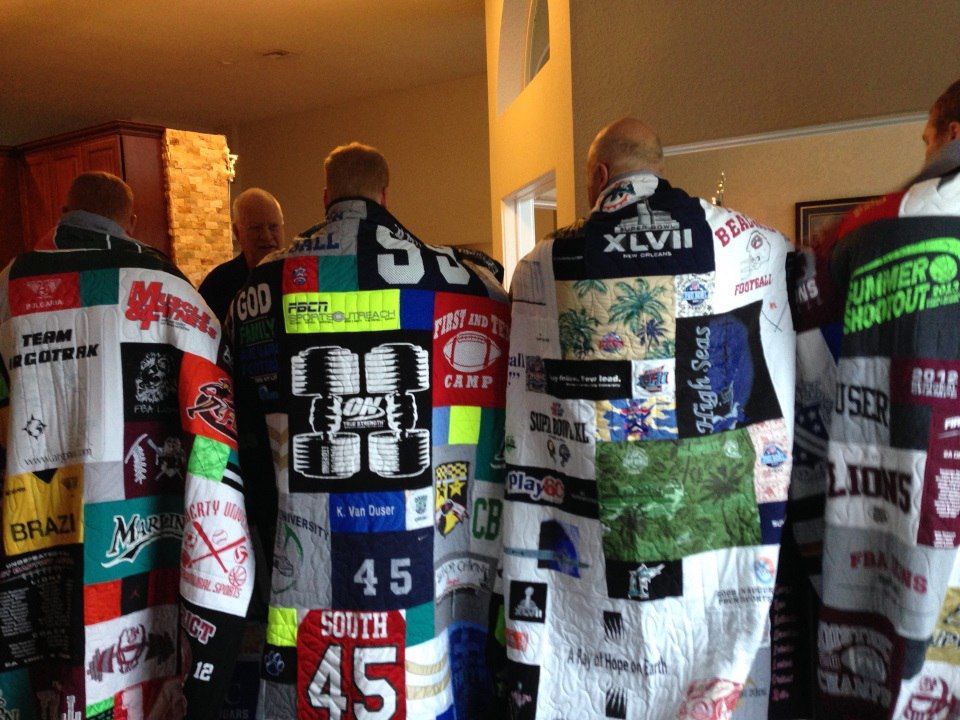
5 Places to photograph a quilt
-
On the Floor
-
On a Bed.
-
Hanging
-
Being Used
-
Flat - overhead
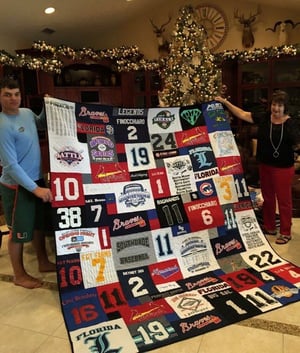 Photographing a T-shirt quilt, or any quilt, is difficult. It’s an odd shape to photograph. It’s large. It’s flat. It’s one-dimensional. It has texture. It’s floppy. Just figuring out where to photograph a T-shirt quilt can be difficult.
Photographing a T-shirt quilt, or any quilt, is difficult. It’s an odd shape to photograph. It’s large. It’s flat. It’s one-dimensional. It has texture. It’s floppy. Just figuring out where to photograph a T-shirt quilt can be difficult.
I have been making quilts since 1968 and making T-shirt quilts since 1992. In the intervening years, I have photographed 1000’s of quilts. There are not a lot of great ways to photograph them without the right tools.
Below are a number of ways I have photographed T-shirt quilts. Some are better than others. Small quilts are always easier to photograph than large quilts.
At the end of this article I talk about how we take the ransom photos we send our customers. Click here to jump to that part.
1. How to Photograph a Quilt on the Floor
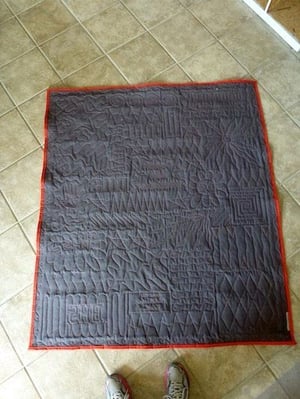
This is a very simple way to photograph a quilt. Spread the quilt out on the floor and snap a photograph. Here are two issues to consider when you photograph a quilt on the floor.
- The flooring.
Obviously, you want the floor to be clean. But also consider what material the floor is made from. Is it wood? Is it tile? Is it carpet? The best choice is a floor that “reads” one color. For example, wood floors at a distance read tan.
Will the floor material distract from the quilt? For example, a rug with a design may distract from the quilt.
- The angle of the photo.
When you photograph a quilt on the floor, the quilt won't be photographed straight on. It will be a trapezoid. This is okay if you are just documenting your quilt. But it will look kind of wonky.
2. How to Photograph a Quilt on a Bed.
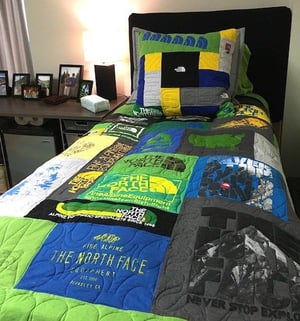 Photographing a T-shirt quilt on a bed is an obvious choice. After all, it’s generally where quilts are used. There are numerous things to take into consideration.
Photographing a T-shirt quilt on a bed is an obvious choice. After all, it’s generally where quilts are used. There are numerous things to take into consideration.
- The Background.
Generally, a bedroom is a private and personal space. Is the room you have available going to distract from the quilt? - Background Clutter
This is more than just dirty clothes all over the place. This is about the nightstands and other personal items that you stop seeing because they are just always there. Clear off the top of the nightstands and dressers. Remove any other personal items while you are taking the photo. 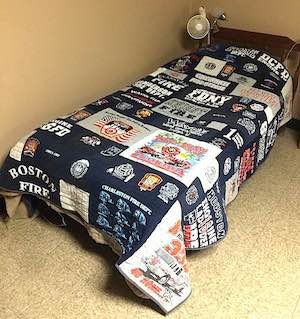 The Underlying Covers
The Underlying Covers
If you just lay your quilt on top of your existing covers or blankets, will those covers been seen? This might be a distraction in the photograph. If the quilt won't cover the entire height of the mattress, consider removing underlying blankets.- The Shape of the Room
Can you get far enough back from the bed to get the entire bed in the shot? If not, this might not be your best choice of locations.
- Pillows
Is the quilt large enough to cover your pillows? Does your quilt extends over the pillows? If so, your photograph will look better if you use one pillow rather than a stacked of two. Also, remove any throw pillows from the bed while you are photographing. 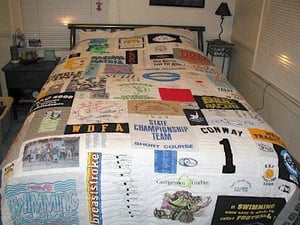 Lighting
Lighting
Typically, bedrooms are not well lit. If the room is too dark, you will need additional lighting. This can be from other light sources or a flash on your camera.- Windows
If you are taking a photograph during the day, will a window throw odd shadows on your quilt? If so, can you close the blinds to eliminate the shadows? - Not All the of Quilt will be Seen
When a quilt lies on a bed, the part hanging over the far side of the bed will not be seen. Will this be an issue?
To learn more about the different types, styles and qualities of T-shirts, download our T-shirt Quilt Buyer’s Guide.
It’s a great place to begin your journey to finding a quilt maker.
3. How to Photograph a Quilt Hanging
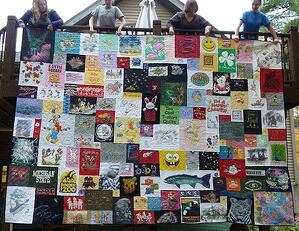
Hanging Between Two People
This is a simple method to photograph a quilt if you have the following…
- Two people and someone to shoot the photo.
- A space for them to hold the quilt without the quilt lying on the floor.
- You need to be able to get far enough back from the quilt to photograph the entire quilt.
A good example of a place to take this type of photograph is outside over a deck.
Hanging from Some Sort of Hanging System
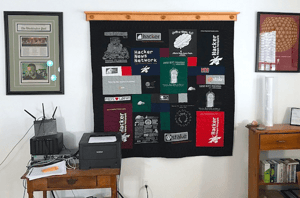 There are many ways to hang a quilt. Read about how to permanently or temporarily hang a quilt.
There are two issues in photographing a hanging quilt.
There are many ways to hang a quilt. Read about how to permanently or temporarily hang a quilt.
There are two issues in photographing a hanging quilt.
- You need to be on the same level as the quilt. If you aren’t on the same level, you will be looking up at the quilt. This will result in the quilt being a trapezoid in the photo.
- You need to be able to get far enough back from the quilt to get the entire quilt into the shot.
4. How to Photograph a Quilt Being Used
This is a great way to photograph a quilt if you aren't concerned with seeing the entire quilt. We love to share photos of people wrapped-up in their quilt. We love to see cats, dogs or babies on the quilt.
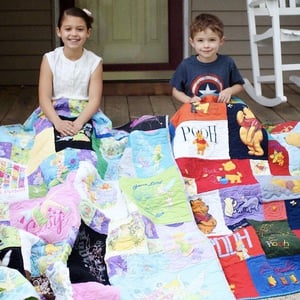
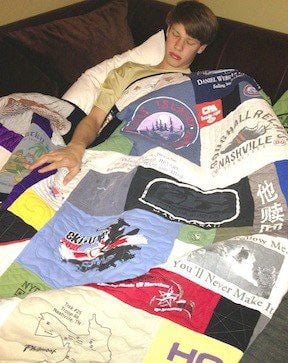
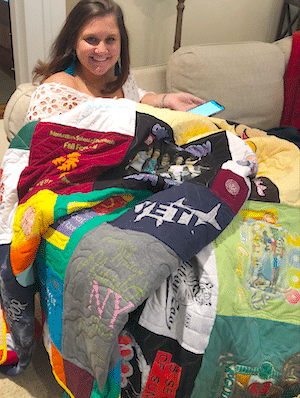
5. How to Photograph a Quilt Flat
This is the most difficult and the easiest way to take a photo of a quilt.
Difficult
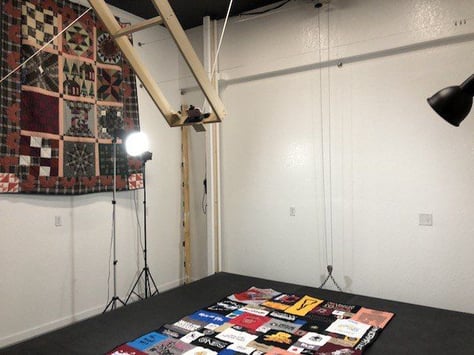 Taking a photo of a quilt flat is difficult because you need the right set-up. This set-up includes:
Taking a photo of a quilt flat is difficult because you need the right set-up. This set-up includes:
- A large flat area to lay the quilt. This is called a stage or table.
- An overhead camera. The camera must be far enough away from the quilt to capture the entire quilt. This means you will need high ceilings.
- The camera needs to be able to take a photograph remotely. This is easy with a cell phone and a remote clicker.
Most importantly, the camera must be perfectly parallel to the quilt. If it is off a degree or two, the quilt will be a trapezoid in the photograph.
Simple
It’s simple only once you have your set-up perfect! Then you just need to lay the quilt on the stage or table. Place the camera in the overhead mount and hoist the camera into place and snap your photo.
How we take our ransom photos.
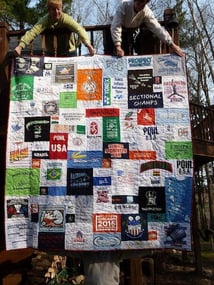
We have used many of the above ways to take photographs of customer’s quilts.
We initially used the hold between two people method. With smaller quilts, we would just have two people hold the corners. With larger quilts, we would go outside and hang the quilt over the deck railing. This had many issues…
- The weather. In the summer, it was too hot. In the winter, it was too cold. And when the weather was just right, we wouldn’t want to go back inside and work!
- Wind. It’s difficult to take a photo of a quilt flapping around in the wind.
- Rain. Snow. We are in Michigan after all!
- Sunlight and shadows. This always made the photographs less than ideal.
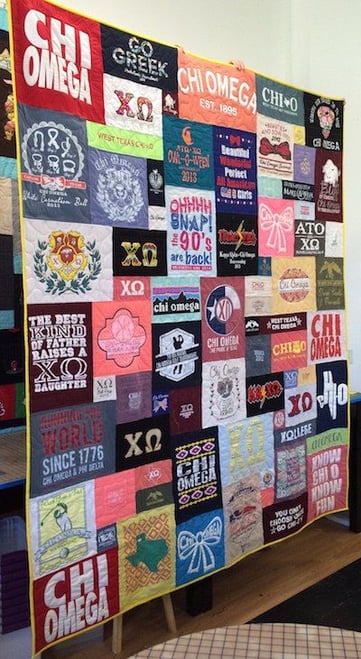
The next stage in our photo shoot progression was to have a large area inside where two people could stand on a table and hold a quilt off the ground. The photographer could get far enough back to capture the entire quilt. This had issues such as the holders whining that the quilt was too heavy. (We need to work out more!) There were also background conflicts.
Then we made a loft area where people could hold the quilt up over a railing. This was similar to taking a photo off the edge of a deck. This worked well. But I wanted something better.
Our Overhead System
We designed an overhead system. This includes a stage painted flat black. This is what we lay the quilt on for its photo.
We mount our camera in a cradle that we hoist overhead with a pulley system each time we take a photo. We have a remote that we click to trigger the shutter.
We have lights we leave set-up and turn on during the photo shoot.
The result is some great photos. But we do have one major challenge. This is setting the camera in the cradle so it is perfectly parallel to stage. If we are off, the quilt looks like a trapezoid in the photo.
We do our best.
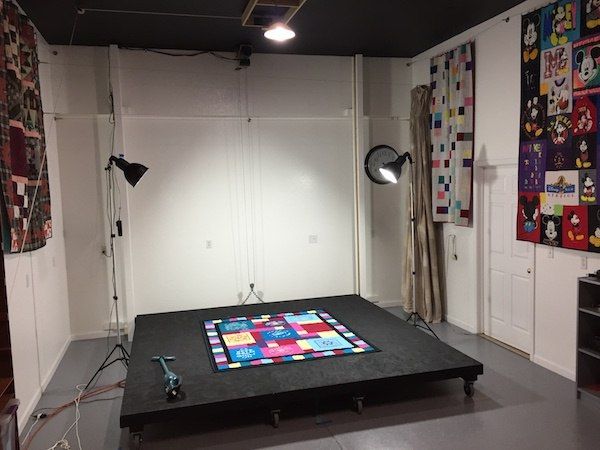
We have two issues with overhead photos that we never had with photos taken any other way.
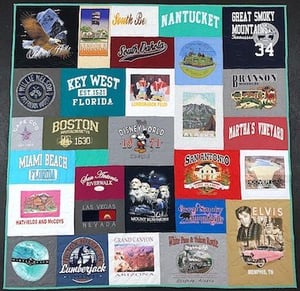 The trapezoid issue.
The trapezoid issue.
Many customers express concern their quilt is actually a trapezoid. We assure them that it is just the camera angle. We have to explain our system so they understand that it’s not 100% fool proof.- The black background.
After we take a photo, we crop the photo so there is a slim border of the black background around the quilt. In some cases, this looks like there is a border on a quilt, when there is none. It’s another thing we sometimes have to explain.
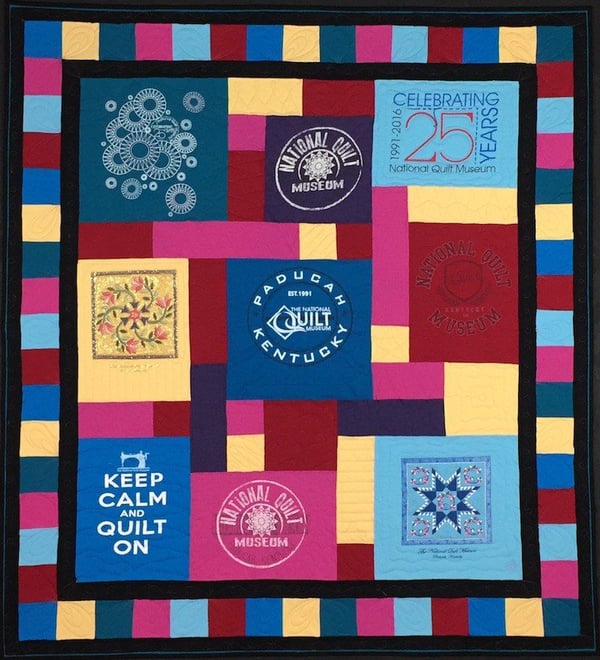
Perception of Photographed T-shirt Quilts

The perception of your T-shirt quilt in a photo is different than it is when you are holding the quilt in your hands. Looking at a quilt laid out flat in a photo is a much different experience than when you are using the quilt.
*** Do I want to say this? ***
Some customers get fixated on one thing in their quilt when looking at the quilt in a photograph. They hate how some part of the quilt looks. They think something looks crooked. They express concern that the colors of the fillers are wrong.
But the issues a customer fixates on wouldn’t be an issue had they not seen the quilt in a “perfect” or flat photograph first.
How you look at a quilt in person is different than how you look at it in a photo. Something small you may fixate on in a photo, isn't even apparent in person. In person, your quilt is 3 dimensional. It has texture. It has smell. It’s so much different. So much better in person.
Before we used overhead photographs, we never had issues like these.
We hope this article helps you figure out how to photograph your quilt.
See more photographs of Too Cool T-shirt Quilts here.
To learn more about the different types, styles and qualities of T-shirts, download our T-shirt Quilt Buyer’s Guide.
It’s a great place to begin your journey to finding a quilt maker.
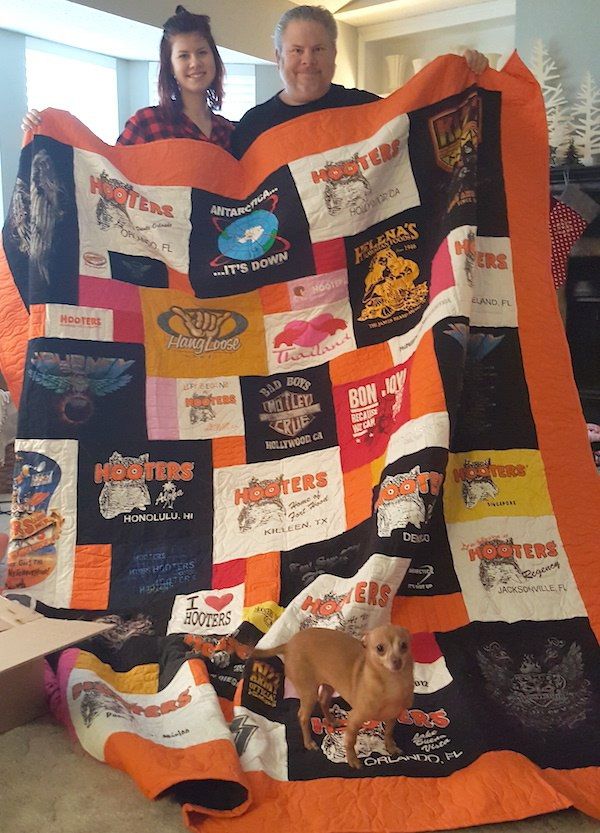
Andrea Funk is the inventor of T-shirt quilts made with multiple blocks sizes. The modern method of making T-shirt quilts. In 1992 she founded Too Cool T-shirt Quilts. Her life has been immersed in T-shirt quilts ever since.


